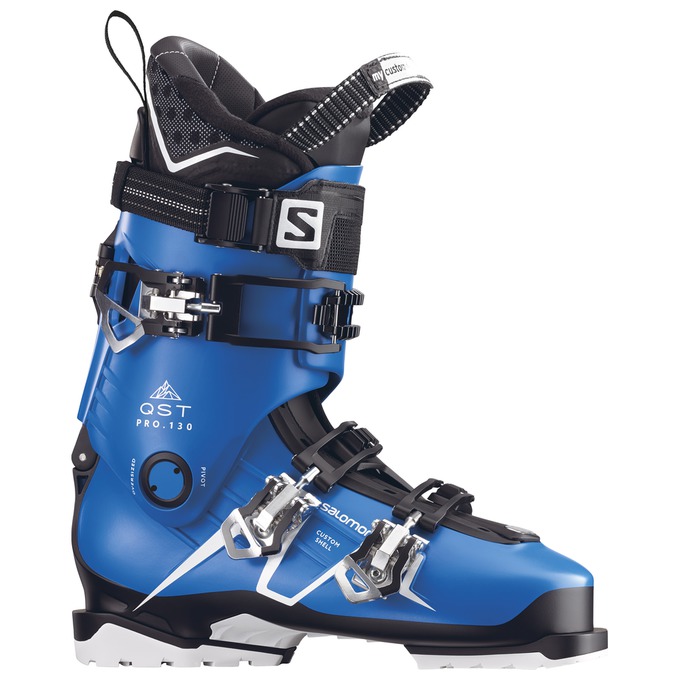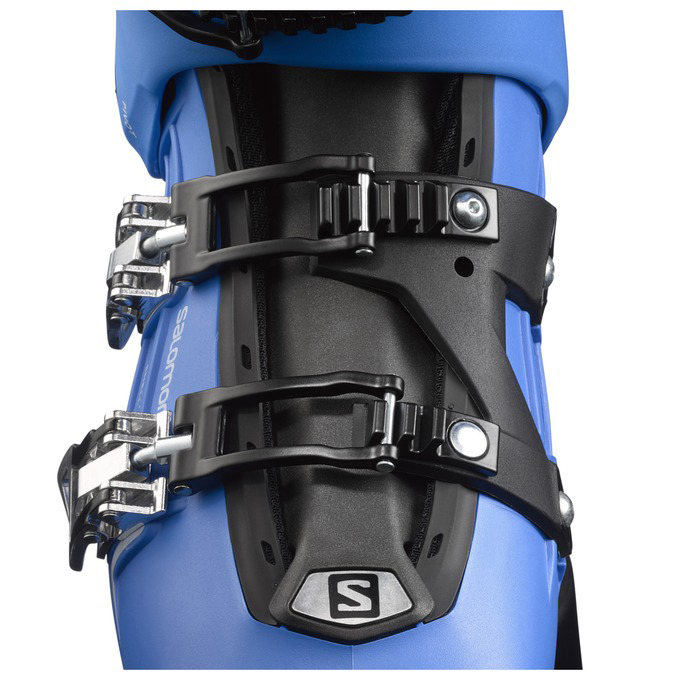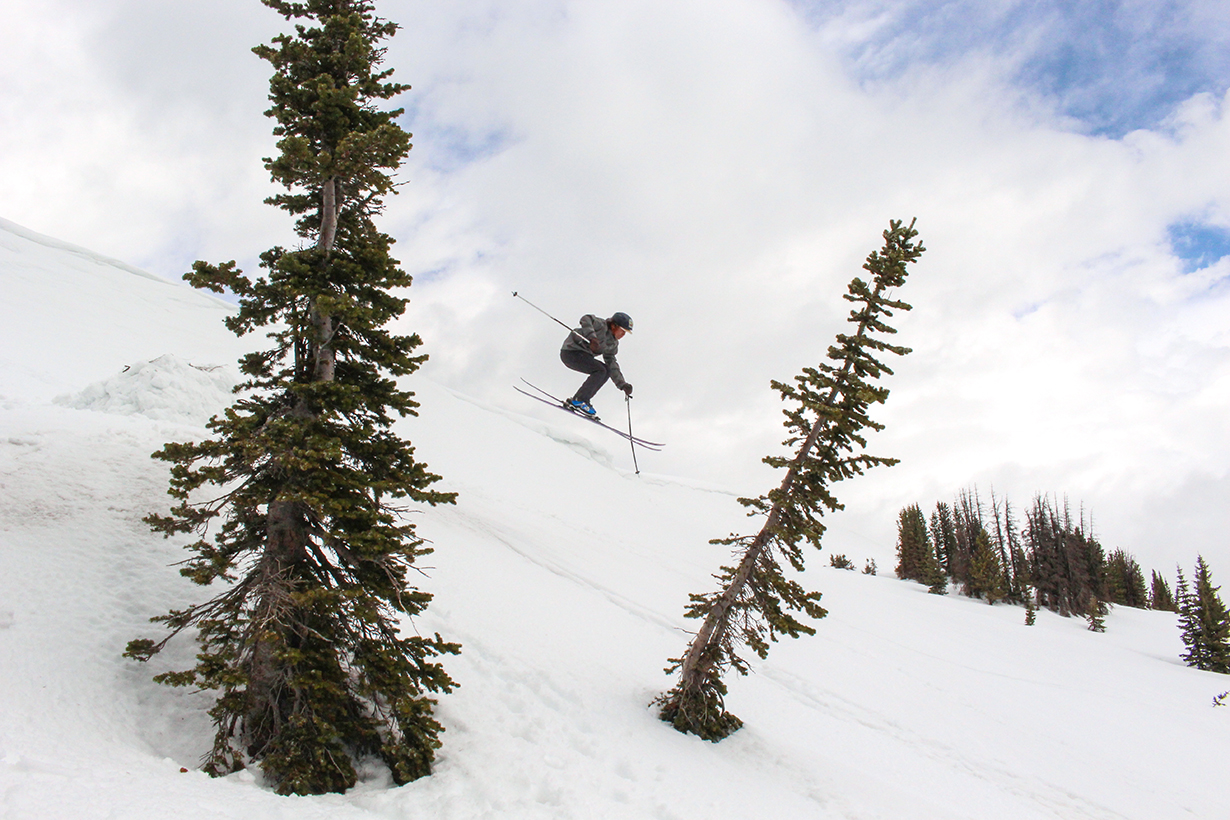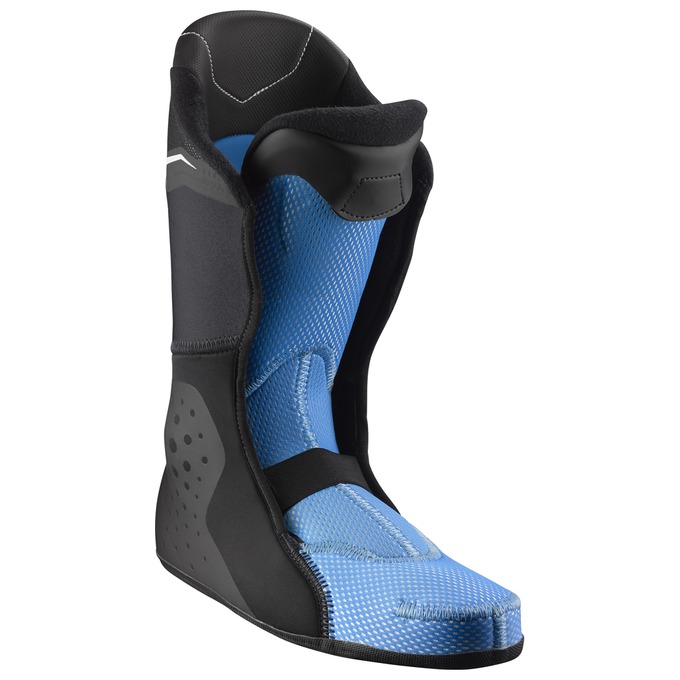
2019-2020 Salomon QST Pro 130
Sizes Tested:
- 26.5 / 305 mm Boot Sole Length
- 25.5 / 295 mm Boot Sole Length
Stated Flex Rating: 130
Stated Last: 100-106 mm (heat moldable shells)
Stated Range of Motion: 40 degrees
Binding Compatibility with the alpine sole blocks: alpine bindings
Binding Compatibility with the tech sole blocks:
- Pin-style (“tech”) bindings
- MNC (Multi-Norm Certified) bindings
Stated Weight per Boot (size 26.5): 1650 g
Blister’s Measured Weight per Boot:
- Shells with alpine soles, no liners: 1347 & 1349 g
- Shells with tech soles, no liners: 1389 & 1391 g
- Liners (with spoilers, no footbeds): 273 & 274 g
- Total Weight with alpine sole blocks: 1620 & 1623 g
- Total Weight with tech sole blocks: 1662 & 1665
MSRP: $699.99 USD
Test Locations: Craigieburn Valley Ski Area, Porters Ski Area, NZ; Cameron Pass, Rocky Mountain National Park, and Arapahoe Basin, CO
Total Days Tested: 18
[Note: Our review was conducted on the 16/17 QST Pro 130, which was not changed for 17/18, 18/19, or 19/20, apart from graphics.]
Introduction
For the 16/17 season, Salomon’s new QST series of boots replaced their popular “Quest” line of boots, and the QST series comes back unchanged for 17/18.
We covered the QST Pro 130 in our 16/17 Buyer’s Guide and we had three different reviewers in this boot this past season to further home in on the particularities of the Pro 130.
The tagline for the QST Pro 130 is simple: “Excel in all playgrounds.”
So what does that sort of all-round excellence look like?
According to Salomon, the recipe includes a swappable DIN-compatible soles and tech soles, a 40° walk mode, a stated weight of 1650 grams, and a unique hybrid tongue design.
That all puts the QST solidly into “crossover” territory — boots that are light enough and walk well enough for longer tours, yet are also compatible with alpine bindings and are powerful enough to ski inbounds. So the QST boots are more inbounds-oriented, do-everything boots than Salomon’s more touring-specific MTN Lab and MTN Explore.
So we’ll be weighing in here on how the QST Pro 130 performs at the resort and in the backcountry, and we’ll be making comparisons to some other similar boots.
Design
The Salomon QST Pro 130 is not quite a traditional overlap alpine boot, nor is it a Cabrio-style, three-piece tongue design. While it does have a tongue, it sits underneath the main part of the shell rather than on top like most other Cabrio designs.

The tongue design — called “Endofit” — is inspired by Salomon’s running shoes. The aim is to wrap the top of the foot and create a more secure fit, and it works. A large amount of overlapping plastic in the cuff closes across the tongue with a single buckle and a camming powerstrap. The tongue attaches directly to the liner, which uses a thick flap to bind and a strip of velcro to secure. It’s an intriguing and unique design.
Fit
As always, we’d recommend that you see a competent bootfitter. Boot fit is a very personal thing and has a huge impact on a boot’s performance. However, we can offer the fit impressions of three of our reviewers.
The Salomon QST Pro 130’s shell is heat moldable, and its 100 mm last can expand to 106 mm, creating a customized width across the entire lower shell.
Brian Lindahl:
After initially fitting the size 25.5 shell, the QST Pro 130 fit me well except in the toe box, where it was a bit too narrow. This is unfortunate because, while the heat molding process for the shell is pretty great, the QST Pro 130’s stock liner has a pretty pointed toe box. Without the shell, the liner itself — even after molding — feels really tight on the width of my toes.
So at the end of the process, I had a boot that fit really well except for the toebox. While I could definitely ski in the QST Pro 130 all day, I think that if the liner had a wider toebox, it would have been even more comfortable for me. So while you can change the liners for a better fit (I tried my Intuition Pro Tours), the QST’s stock liner has some special features to bind it tightly to the tongue of the shell, and I don’t think that the QST would ski as well with a different liner — the shell and stock liner are designed to work together as a single system.

The last comment I have on the fit of the Salomon QST Pro 130 is about the instep. The Endofit tongue doesn’t give you a lot of options for increasing instep height, and the bootboard is very minimal, so grinding it wouldn’t give you much (if any) extra space). While the instep height was fine for me, I could see this potentially being an issue for other people. Jonathan has a higher instep than I do, and before the heat molding process, that instep was too tight. After the heat molding process however, enough room was made to create a very comfortable, snug fit.
It would be nice to see Salomon include a thicker boot board in the future to provide more fitting options. On the flip side, the Endofit tongue, if it does fit you, really does bind your foot well to the boot. Not only is it very secure, it’s also quite comfortable.
Luke Koppa:
For reference, I have a low instep, wide forefoot, and my feet taper a bit from the forefoot to the end of my toes (i.e. my pinky is much shorter than my big toe). The most common issue I have in ski boots is pressure on the outside of my forefoot, which is something that I experienced with the Fischer Transalp Vacuum TS, despite having the liners and shells heat-molded.

The size 26.5 QST Pro 130 fit me pretty well out of the box. After spending the first couple days figuring out my ideal buckle setup, I could wear the boot comfortably all day touring or riding lifts with very little pain in my forefoot. Unlike Brian, I had no issues with the toebox being too narrow, which makes sense as my feet are fairly pointed.
The Endofit construction worked great for my low instep, and is likely the most comfortable instep fit I’ve had in a boot. But as Brian mentions, the unique construction and minimal bootboard don’t allow for much customization for those with higher insteps.

(BTW, I tried the QST Pro 130 with the liner from the Salomon MTN Explore, which, despite being from a dedicated touring boot, was thicker and sturdier than the QST Pro 130’s stock liner. However, I didn’t experience much of an increase in downhill performance, and since the special velcro flap on the QST Pro 130 stock liner attaches securely to the boot’s tongue, I have since switched back to the stock liner.)
Jonathan Ellsworth:
A bit about my feet:
Length (Left & Right): 271 & 274 mm
Width (Left & Right): 100 & 99 mm
Instep Height (L & R): 79 mm & 75 mm. (The Boot Doctor’s Charlie Bradley describes this as a “high arch / high instep” — on a scale of 1-10, he calls my arch / instep a 8 or 9).
Charlie also notes about my feet: Fairly stable, solid platform. A bit of pronation. A good amount of ankle range of motion (aka, “dorsiflexion”).
While I have often downsized to a size 25.5 when reviewing boots with a 100 mm last (I downsize in order to achieve the most secure heel hold I can — since it’s typically easy to create more length or width in the toebox of a boot), but since I would be touring in the QST Pro 130, I didn’t want to end up with a super-tight, alpine-boot fit that might prove to be painful to tour in. So I opted for the 26.5 QST Pro 130.
As both Brian and Luke have touched on, the most notable fit point for me was the relatively low instep of the QST Pro 130. As Brian said, prior to heat-molding the shell, the QST Pro 130 was crushing my instep. But after the heat molding process, that instep issue for me was largely resolved, and I really want to echo what Brian wrote above: “the Endofit tongue, if it does fit you, really does bind your foot well to the boot. Not only is it very secure, it’s also quite comfortable.”
“Snug and comfortable” is pretty much the best possible thing you can say about a boot, so while none of us here are willing to guarantee that the fit of the QST Pro 130 will work for you, we all will attest that with the right feet, this is a design that can yield an impressive fit for a touring boot — snug yet still comfortable to tour in and wear on longer days.
NEXT: Touring, Stiffness / Flex, Etc.

You said that the rear support is lacking. How does it compare with the Lange Free tour 130 in this regard?
I find the Free tour a bit lacking in rear support though mostly on carpet, not really skiing.
Hi Rod,
I haven’t skied the Lange XT Free Tour 130 before, Paul Forward is the only reviewer at Blister who has. He said it had comparable downhill performance to the Lange XT 130. He’s also skied the prior season’s Cochise Pro 130 (when it first became orange), but he doesn’t speak to the rearward flex comparisons with the Lange XT 130 (MAYBE because they were the same?). I’ve spent a lot of time in that same season’s Cochise 120, and can definitively say that the Cochise 120 (bright green version) has a noticeably stronger rearward flex than the QST Pro 130. I can also say the same about the current Cochise Pro 130. Draw what conclusions you want to from this, but unfortunately, I can’t say for sure how the Lange XT Free Tour 130 would compare to the QST Pro 130.
You said that the boot doesn’t have that burly feeling you experienced with other 130 flex boots. Did you find it too soft to ski very aggressively? I am in the market for a new pair of boots and the qst 130s were one of the options. I am a very aggressive skier but also pretty lightweight (150 lbs). Do you think the qst 130 won’t be enough boot for me? I tried on the cochise 130s and found that the boot wasn’t as secure around the higher portion of my ankle; the qst was more snug there. In addition, the qst 130 fit pretty well out of the box on me. I have not tried on the lange freetours; is that something you would recommend? Are there any others you would recommend? Thanks for the advice.
Hey Zac,
My experiences in skiing this boot very aggressively are in firm, variable conditions (I didn’t ski it in powder conditions). I found that the FORWARD flex of QST, while softer than other 130-flex boots, was adequate for skiing aggressively in these conditions. However, the REARWARD flex of the boot gave me some problems.
Generally speaking, I don’t pressure the rear cuff as part of a normal skiing stance (perhaps when loading up the tails at the end of a carve). However, when getting bucked off balance in firm, variable conditions, I found that the softer REARWARD flex of the QST made it quite difficult to recover. I.e., when off balance, the rear of the boot gave way and further compromised my stance and balance, and I’ve never had this trouble in boots that have stiffer rearward flexes. This was most prevalent when speeding across smooth, firm snow, then suddenly encountering rougher firm snow – i.e. getting knocked off balance by a rut. I also found it to be a problem when airing into rough firm snow (minor mogul fields).
And, while I haven’t skied the Lange Freetour, our reviewer Paul Forward has never mentioned any such issue with the rearward support of those boots. So I think you probably should take a look if you’re really putting a premium on stability at speed in variable conditions — and especially if you’ve ruled out the Cochise 130 (for which I found the rearward flex to be stiff enough for this sort of skiing).
Hi Brian,
I have read the review and the 101 on bindings, I am planning on buying this boot, it will be my first 50/50 boot. I have tried the 120 at a store and it fits very well, but I think I would prefer the flex of the 130. Could you confirm my logic for buying it and my understanding of sole compatibility please?
I am 65, my current boot is a 2007 Salomon XWave 100 flex, bought when I was just getting serious about skiing. It served me well but it is done and I need a new boot now. I am more of a finesse skier than a charger. I am climbing a fair amount in the resort and side country and I hope to get some real touring in the the 2018_19 season.
1) I expect this to be my new resort boot for some time. The lighter weight and flexibility are positive attributes and I will get more control from this boot, especially laterally then from the old one, so I don’t have to buy a resort only boot.
2) The QST Pro boot can not be skied safely in ISO 5355 bindings with the AT soles? – If this is the case, then on occasion, maybe 12 times, I could swop to AT soles and rent/buy AT skis. This will give me some experience of skinning.
3) If touring becomes a thing I do a lot, then I would buy dedicated a tour ski and boot and use the QST for the resort only.
Thanks in anticipation!
Gregory
Hi Gregory,
“The QST Pro boot can not be skied safely in ISO 5355 bindings with the AT soles? – If this is the case, then on occasion, maybe 12 times, I could swop to AT soles and rent/buy AT skis. This will give me some experience of skinning.”
Salomon does not recommend frequent swaps of the soles. The soles use wood screws directly into the plastic and frequent swapping may compromise the ability of the screws to hold.
Hi,
I am quite lost in ISO norms. Is it possible to use this boot with walking tech pads into Marker sole id binding or tyrolia attack binding? Thank you for your answer.
If you have the tech soles (the ones with the rubber soles) on the QST Pro, you could use them in a Marker Sole ID binding or other “Multi Norm Certified” (aka, “MNC”) bindings like the Tyrolia AAAttack2 14 AT and Salomon Warden. The QST’s rubber soles are *not* compatible with alpine bindings that are *not* MNC certified, such as the “GW” version of the Tyrolia AAAttack series, the Salomon STH, Look Pivots, or any of the Marker bindings that do not feature their Sole ID toe piece.
Hi Brian, I just looked at the the info and the podcast on the Salomon S/LAB SHIFT MNC. So, I f I get this binding I will be able to use AT pads all the time! What a deal!
Gregory
do these boots come with the DIN compatible sole plate? Thanks!
Hi Chris, yes they do.
If the liner of the 130 is anything like the liner in the 120, I can attest to Brian’s comments on its fit and function. It is decidedly different than the more ‘traditional’ liners, especially in the toebox, in that it is firm and unforgiving in terms of moldability. After molding and trial use I moved off the boot b/c I had to upsize to make the liner work but then the fit of the shell was lost. Unfortunate b/c I really liked the weight and feel of the Endofit tongue. YMMV.
I have 8 days in these boots, I like them. I had to do the the “sixth toe stretch” to the boots AND liners – the liners are too narrow in my opinion but the stretch worked, now the fit is excellent. I get good lateral control and progressive forward flex. I love the reduction in weight. from my alpine boots. I read Brian’s mention of lack of support in the rear, but had no issue UNTIL I landed on my tails on a jump in my local terrain park. The left boot dug into my calf around the hight of the power strap and has given me a lasting deep bruise. I don’t think this would have happened in my regular alpine boots. It’s bummer because I am going to struggle with this injury. I have removed the plastic spacers that attach to the rear of the liner with velcro, this gives me a slightly softer feel back there with a better spread of pressure. I think the inserts are supposed create a tighter fit towards to top of the boot, but probably what is going on is the boot is too rigid at the back and creates a narrow pressure point with sudden back pressure. Now I am a little weary about them. I am doing 6 days at Snowmass at the end of this week and will add a comment on how it goes.
Correction to the bit about the plastic inserts on the back of the liner. After fiddling around a little bit I have put them back in, but higher up. They protrude above the rear cuff by 3/4″ now. I think this moves the pressure point higher and spreads it a bit better.
Hey everyone,
I thought that I would leave this comment in case there are any women looking at getting into this years QST Pro 90. I didn’t have time to read this whole post but after reading about the lower shin/upper ankle pain I figured I should say that this is also a major problem in the women’s version of the boot. I bought this boot brand new in December 2018 and only did 2 very long tours on it (a 20 km day trip, and a 50 km hut trip). Sadly, these boots made it impossible to do any skiing due to the extreme shin pain from touring. Unfortunately, I’ll have to get rid of these boots and into something different when my shins heal. For me, this was severe enough that my doctor is now looking into the potential of stress fractures on both lower shins.
I assume it was due to the extremely long tours that made this so painful, but a few consecutive shorter days would have likely done the same thing.
Sorry guys, it looks like I may have left this comment on the wrong review of this boot (as I notice now that this one does not mention others with shin issues). However, I figure I’ll leave this here in the case that there are still other women looking for a review on the women’s specific boot.
I’m try to understand the differences in Salomon’s line-up. QST 120 vs MTN S/Lab vs Mtn Explore.
Stiffness: 1 MTN S/Lab, 2 QST, 3 Explore
range of motion: 1. Explore, 2 MTN S/Lab, 3 QST
comfort?
which skis the best?
why would one pick the QST over the Explore?
Hi Lawrence,
It’s hard to say which is stiffer… the MTN S/Lab or the QST Pro 130. I’d likely have to ski them back to back to know for sure. The Explore is definitely softer. Your range of motion list looks accurate to me.
As for comfort, it really depends on your foot. I can’t answer that question.
Again, for which one skis the best, I’d really have to ski the MTN S/Lab and QST back to back to say for sure. I felt that the MTN S/Lab was also lacking in rearward support, for me, personally, which was my biggest complaint about the QST’s downhill performance.
The QST skis better than the Explore. It also has DIN compatibility, which the Explore does not.
I skied the QST 130 Pro for roughly one and a half seasons. I used it as a “50/50” boot, realistically skiing 90% inbounds. After somewhere around 40 days the stock liner was entirely packed out, and actually had lost all pull tabs and had blown out multiple stitches holding the toe box area together, as well as lost the glue holding the foot of the liner to the rest of the liner. After 50-60 days I lost the pin on the right boot that holds the walk/ski mode engaged, the same thing happened soon after to the left boot. I was able to fix this with a machined screw since Salomon had no parts available. The actually mechanism (that u would use to engage/disengage the walk mode) also began to wear on itself causing a small, albeit noticeable amount of play in the boots while in ski mode. Then roughly around 80-90 days I broke off the lowest buckle on my right boot (buckle over toe box area). I also went through two sets of heel blocks during ownership of this boot due to the heel area that the alpine bindings connect to wearing out.
Aside from all of my issues with this boot (and zero assistance from salomon due to no parts available and no boots in stock for warranty), I found this boot to be lacking in rearward support. If you were caught in the backseat, these boots lacked in the support to rebound. Intuition Powerwraps greatly increased the overall support of these boots, but did not align well with the tongue of the boot (tongue is too narrow to fully wrap the liner).
I thought that these boots actually tour quite well. I never spent more than 12hrs a day touring in them, but always found the ROM and weight to be fine for my needs. They would make a strong, although heavy dedicated touring boot.
I now ski the newest models of Lange RX 130 LV and XT 130 Free LV. IMO there is no comparison as far as support between the Lange boots and the QST 130 Pro, even though I actually felt the Salomon fit my foot slightly better after proper fitting.
Has Salomon improved the 2019/2020 model with a stiffer rear flex support?
As far as we’ve been told, Salomon has not updated the QST boots since the version we reviewed, apart from colors.
Hello
I’ve had the boots for a while now and really like them. They came with 2 plastic hard pieces which might be inserts to place at the top of the calf between the liner and shell. Is that correct. Thanks Mike